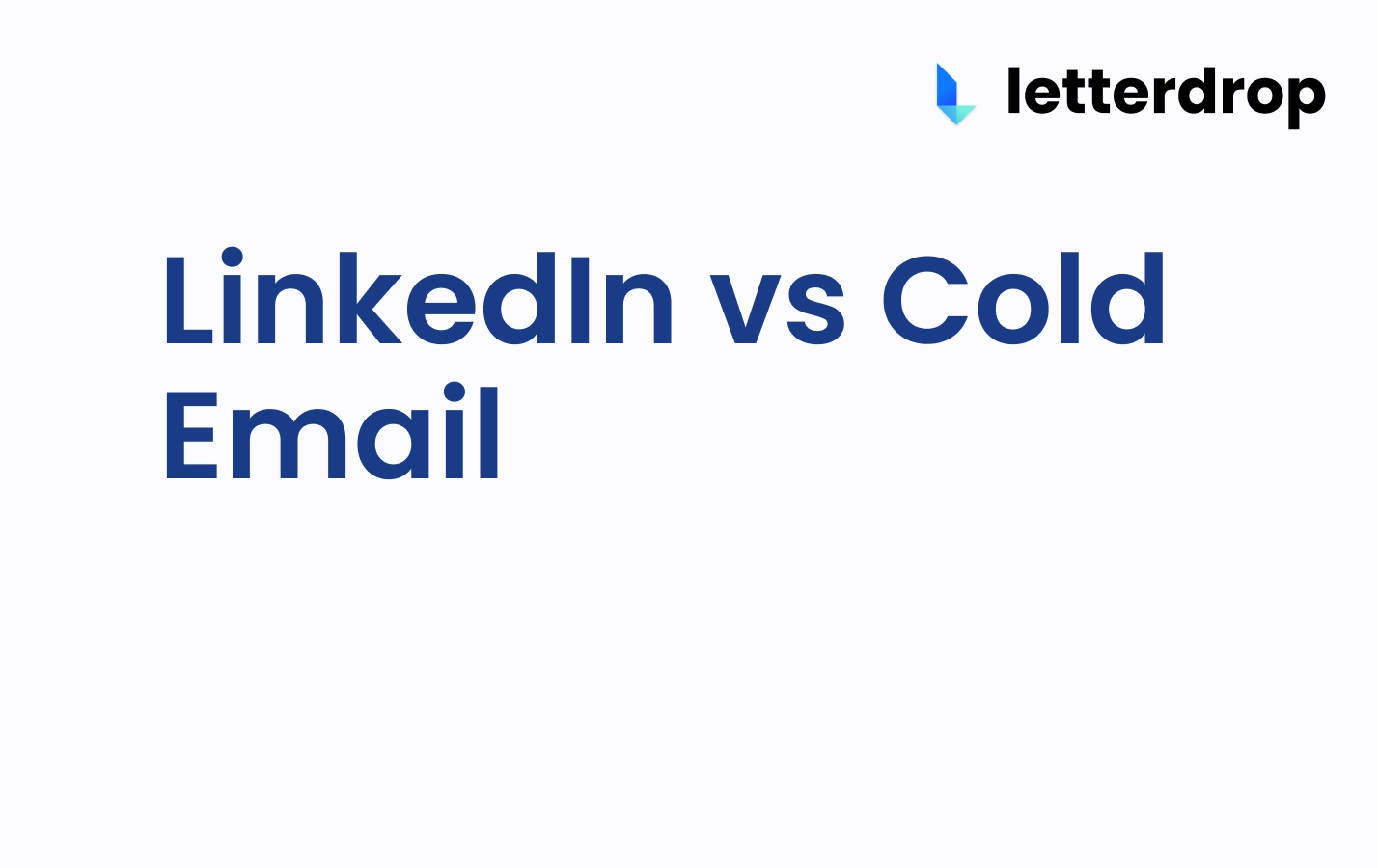How to Build a More Effective ABM Strategy
TL;DR:
- Most companies are approaching ABM wrong in 2025
- Focus on personalized outreach and content for target accounts
- Shift away from traditional outbound and paid methods
- Build a strong product marketing foundation
- Utilize organic ABM supplemented by paid strategies for maximum efficiency
You're running an ABM program. If you think this just means running ads and going all-out on an outbound email campaign, think again.
Marketing budgets are under intense scrutiny in 2025. Here's how to make your ABM strategy more efficient.
How ABM Fails Today
There are a couple of reasons why your ABM program might be failing today.
- Having a bad list. You’re going after companies you maybe shouldn’t be targeting. You’re just using some arbitrary SalesNav filters and saying, ‘Hey, here’s who we want to go after,’ without real qualification. This isn’t B2C where demographics like age or income matter
- Poor alignment between sales x marketing. You need every single person who’s outbounding plus the demand-gen team to be coordinated and synced. Most SDRs just go after whoever they want, and marketing ends up running ads against a different list
- Unimaginative execution. The classic ABM program is running LinkedIn ads, then getting SDRs to reach out to whoever clicks or visits the website. You need to be doing more than that
- Ignoring personal branding. You can’t expect a random SDR with no online credibility whatsoever to succeed – you need them to close that gap
The bottom line? Most companies focus on forking out thousands of dollars on more BDRs to push cold outreach and more paid ad campaigns.
Why Doesn't This Type of ABM Work?
Don't get me wrong — this method of "throwing enough money at the problem" could work if you have the resources to wear down your accounts completely.
But problems follow:
- The prospects you're targeting this way might not be in market to buy, and no amount of outbound or money is going to change that
- People get in market to buy because there's a project or initiative they're in charge of that that requires adopting a new solution — they rarely buy just because something better comes along
You're ultimately spending an inexcusable amount of money just to find out your prospects aren't going to buy.
This kind of marketing spend worked in 2021 when capital was abundant and markets were frothy. But in 2025, marketers have to be more efficient with less resources and headcount. The playbook has changed.
Euridite's James Hanzimanolis has this to say about dragging in more SDRs only to lay them off later.
“It's completely unethical to say 'let's hire 20 SDRs' only to lay them off three months later because you didn't plan ahead. If they don't 3x their costs, the ROI isn't there.” — James Hanzimanolis (Euridite)
I also talked about this with Nicholas Chan, CEO and founder of GTM Social.
"There's a new playbook coming in where companies are scaling and getting customers by doing great content marketing and distributing that content in the right place." — Nicholas Chan
How to Build a More Efficient and Effective ABM Strategy
Step 1: Define the Target Data
The first component of an ABM program is identifying who you want to target and why.
As ScrappyABM founder Mason Cosby explained to us, most companies focus only on firmographics like revenue and industry. But you also need a "trigger" - a tangible reason to reach out.
You need to be crystal clear on:
- who your customer is at these target accounts
- what their top problems are
- what the cost of these problems is
- what the status quo or default state of things are
- why they need to solve these problems
- what the triggers that make these problems important to solve
- what possible solutions are
- why you are the best fit versus alternative solutions and how you're different
Once you understand your product, you need to create your content.
- Your content has to be trustworthy. Reach out to experts in those specific subjects
- Your content has to be formatted in a way that your buyer wants to consume. This might be long or short form, video or text, depending on the question and goal of the asset. Ask your customers what they want to see and how they want to see it
Focus on Internal Data
If your company is mature, use your historical data to identify the types of customers that have been the most successful. Look at:
- Customers with the fastest sales cycles.
- Deals with the highest ACV.
- Accounts with the lowest churn rates.
If you’re a newer company without enough data, make hypotheses based on the patterns you do see, then test them.
Get Sales on Board
If sales disagrees with the target list, pause and figure out why.
Maybe your list isn’t factoring in which accounts are easiest to sell to. Or maybe sales has other insights you didn’t consider. Address the disconnect before moving forward.
Step 2: Map Out Distribution Channels
Next, determine what distribution channels you will use to reach your target accounts and contacts. This could include display ads, email outreach, online communities, etc. As Mason says:
"Some of my best ABM programs were community plays. I figured out where my accounts were hanging out from an online community perspective."
You need to distribute your content on channels where your buyer already is.
This is where your sales team comes in. They are the human touch that finally closes the loop.
Get your BDRs and AEs to connect with your target account list on LinkedIn and sharing content on their feeds. It's the best platform for B2B selling — we have a guide on turning LinkedIn into a primary acquisition channel.
This improves their connect rate when they actually reach out via email, DM, or call.
Step 3: Create a Destination
You need to direct your accounts somewhere once you capture their attention. This could be a case study, blog, webinar, special offer page, etc.
Step 4: Track Direction
Finally, implement tracking to determine if your accounts are engaging. This indicates they are moving closer to becoming customers. Mason says:
"If you have a designated landing page that you only promote through one designated channel to one designated audience, and you see traffic on that page, and you can de anonymize your account level traffic with a free tool like Warmly."
More specifically:
- Sales-accepted opportunities (SAOs): How many target accounts turn into meaningful conversations?
- Account engagement: How many target accounts visited your website, clicked an ad, or interacted with your team on LinkedIn in the last 30–90 days?
This is where tools like Clay can help you collect public data to identify trends or signals. Combine this data with firmographic filters in SalesNav, ZoomInfo, or Apollo to refine your list.
Step 5: Turn Your Sellers Into Social Sellers
A major blocker to getting more meetings booked via socials like LinkedIn is that no one wants to connect with your sales team. People can smell a sales pitch from miles away.
Sellers don't educate buyers enough.
To solve this, you want to make buyers want to follow, connect, and engage with your sellers. That's where social selling comes in.
Essentially, your sellers need to consistently share value-first content on their platform — their learnings, customer stories, industry best practices, and other forms of thought leadership. They become seen as peers in the space versus sellers.
Greg Costigan (formerly and Zenefits and Box) emphasizes the importance of helping your sellers close the credibility gap that exists between buyers and sellers.
"We've all been sold to. There's this massive credibility gap in your mind.
There has to be [content out there] to help close that credibility gap.
You're trying to build an awareness funnel and trying to drive [prospects] to a center of excellence.
There's still a slight nudge of intrinsic knowledge and confidence that has to develop in [a seller] for them to be an SME in that department, treated as a source of truth to close that credibility gap, be a business advisor." — Greg Costigan
As for what to write about, sales calls are an excellent source for sales enablement both on LinkedIn and on your website.
You can find what's blocking sales and what else customers are searching for.
Letterdrop connects with call software like Gong and Chorus and can:
- Identify objections, product questions, recurring themes, and more
- Automatically recommend relevant content based on call information
- Automatically generate defensible content for you

What Does This Method Do For You?
This "new" ABM strategy means you distribute targeted content to in-market buyers. This:
- automatically gets you hand raisers and inbound pipeline
- helps identify the best-performing organic assets and which accounts are consuming them. What they consume tells you what they care about and where they are in the buyer journey
We've mentioned some tools that can help you de-anonymize important intent data.
Now instead of display ads that just say "Book a demo", you can instead use paid and retargeting ads to scale up the best performing organic assets. You already know they work — use ads to push them to target accounts.
Examples of ABM Tactics
1. Targeted ad campaigns. These could be display ads or social media ads

2. Cold outbound. This includes personalized email messaging or cold calls

3. Gated assets such as e-books and whitepapers that require an email address

4. Marketing emails that are follow-ups after a prospect takes action on your website

5. Webinars and other events

6. Personalized gift cards or other gifts

Organic ABM Supplemented By Paid is the Future
No more resources wasted on excess BDR salary, ads that people ignore, and emails that inevitably get sent to spam.
By focusing on organic ABM and targeted content, you give your sales team the perfect customer acquisition material — and paid can help you get it out there.
Want to read more guides like this?
Subscribe to newsletter
No-BS GTM strategies to build more pipeline in your inbox every week
Related Reading
Some other posts you might find helpful
















